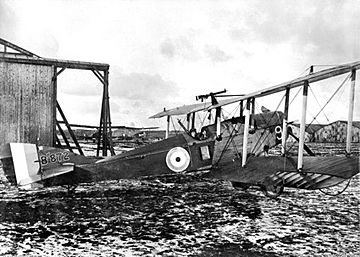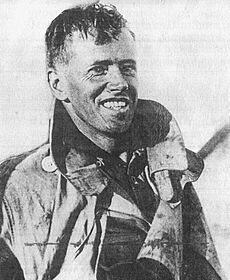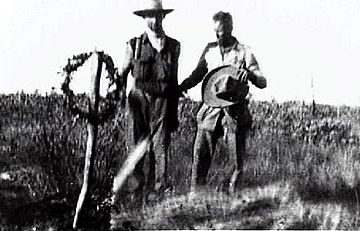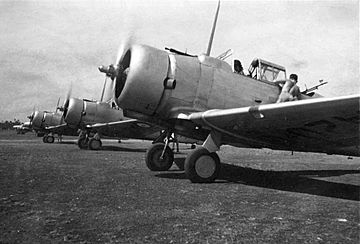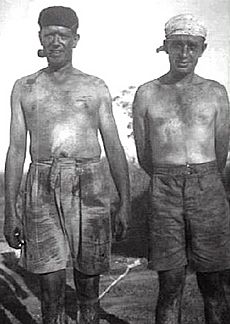Charles Eaton (RAAF officer) facts for kids
Quick facts for kids
Charles Eaton
|
|
|---|---|
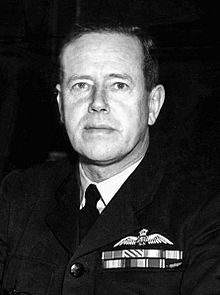
Group Captain Eaton commanding RAAF Southern Area, 1945
|
|
| Nickname(s) | "Moth" |
| Born | 21 December 1895 Lambeth, London, England |
| Died | 12 November 1979 (aged 83) Frankston, Victoria, Australia |
| Allegiance |
|
| Service/ |
|
| Years of service |
|
| Rank | Group Captain |
| Unit |
|
| Commands held |
|
| Battles/wars |
|
| Awards |
|
| Other work | Diplomat |
Charles Eaton (1895–1979) was an important officer and pilot in the Royal Australian Air Force (RAAF). He also worked as a diplomat later in his life. Born in London, England, he joined the British Army when World War I started in 1914. He fought on the Western Front before becoming a pilot in 1917.
As a bomber pilot, he was captured twice by German forces but managed to escape both times. After leaving the military in 1920, Eaton moved to Australia in 1923. He joined the RAAF in 1925 and became a flying instructor. He became famous for leading three missions to find lost planes in Central Australia between 1929 and 1931. For his dedication, he received the Air Force Cross.
Contents
Charles Eaton's Early Life and World War I Service
Charles Eaton was born on December 21, 1895, in Lambeth, London. His father, William Walpole Eaton, was a butcher. Charles went to school in Wandsworth. At age fourteen, he started working for the Battersea Town Council.
When World War I began in August 1914, Charles joined the London Regiment. He was part of a bicycle company in the 24th Battalion. In March 1915, he went to the Western Front. He took part in trench bombing and attacks on enemy supply lines. He fought in major battles like Aubers Ridge, Festubert, Loos, and the Somme.
On May 14, 1915, Eaton joined the Royal Flying Corps (RFC). He started pilot training in Oxford. During his first solo flight, another student crashed into him, but Eaton was not hurt. He became an officer in August and earned his pilot's wings in October. As a lieutenant, he flew Martinsyde G.100 "Elephant" fighters with No. 110 Squadron. His job was to defend London from German Zeppelin airships.
In April 1918, he moved to the new Royal Air Force (RAF). The next month, he went to France. He flew Airco DH.9 bombers with No. 206 Squadron. On June 29, he was shot down behind enemy lines near Nieppe and captured. He was held in a prison camp in Holzminden prisoner-of-war camp, Germany. Eaton escaped but was caught again and kept alone. He later escaped a second time and rejoined his squadron as the war ended.
Between the Wars: Flying and Rescues
After World War I, Eaton stayed in the RAF. He married Beatrice Godfrey on January 11, 1919, in London. He flew for No. 1 Squadron on the first regular passenger service between London and Paris. He flew delegates to the Peace Conference at Versailles. In December, he went to India for aerial survey work, including the first survey of the Himalayas.
Eaton left the RAF in July 1920 and worked in India. In 1923, he and his family moved to Australia. He joined the Royal Australian Air Force (RAAF) as a flying officer in August 1925. He became a flight instructor at No. 1 Flying Training School. He was known for being strict but a good trainer. Here, he got his nickname "Moth" because the basic training plane was the De Havilland DH.60 Moth.
In February 1928, he was promoted to flight lieutenant. He flew a Moth in the 1929 East-West Air Race from Sydney to Perth. This race was part of the Western Australia Centenary celebrations. He finished sixth in the race.
Searching for Lost Aircraft in Central Australia
Eaton was known as one of the RAAF's best pilots for long-distance flights. He became famous for leading three military missions to find lost planes in Central Australia. These missions took place between 1929 and 1931.
In April 1929, he helped search for pilots Keith Anderson and Bob Hitchcock. They were missing in their plane, the Kookaburra. They had been looking for Charles Kingsford Smith and Charles Ulm, whose plane, the Southern Cross, had landed in north Western Australia. Three of the RAAF's five search planes crashed, but all the crews were safe. Eaton's plane crashed on April 21 near Tennant Creek.
On the same day, Captain Lester Brain found the Kookaburra wreck in the Tanami Desert. It was about 130 km (80 miles) east-south-east of Wave Hill. Eaton led a ground team to the crash site four days later. They buried the crew, who had died from thirst and heat.
In November 1930, Eaton led another search for a missing plane near Ayers Rock. But the mission was called off when the pilot was found safe. The next month, he searched for W.L. Pittendrigh and S.J. Hamre. They had disappeared in their plane, the Golden Quest 2. Eaton's team found them on January 7, 1931. A ground party, with Eaton, rescued them four days later. He also suggested a site for Alice Springs' new airfield, which is still used today.
Eaton received the Air Force Cross on March 10, 1931. This was for his "zeal and devotion to duty" during the search flights. The newspapers called him the "'Knight Errant' of the desert skies."
Other Adventures and Promotions
Besides the Kookaburra crash, Eaton had another close call in 1929. He was testing the Wackett Warrigal I plane with Sergeant Eric Douglas. The plane went into a spin, and the controls stopped working. Eaton told Douglas to bail out. When Douglas stood up, the spin stopped. His body had changed the airflow over the tail. Eaton managed to land the plane safely.
In December 1931, he moved to No. 1 Aircraft Depot. He continued to fly and did office work. He was promoted to squadron leader in 1936. Around that time, he went on a secret mission to find good landing spots in the Dutch East Indies. He was arrested in Koepang, Dutch Timor, and held for three days.
Eaton became the commanding officer (CO) of No. 21 Squadron in May 1937. One of his first jobs was another search in Central Australia. This time, he looked for prospector Sir Herbert Gepp, who was found alive. Later that year, Eaton led an investigation into a plane crash. He recommended an award for Aircraftman William McAloney. McAloney had tried to rescue the pilot from the burning plane. He later received the Albert Medal for his bravery.
In 1937, it was decided to build the first RAAF base in Northern Australia. In April 1938, Eaton and Wing Commander George Jones planned the new base and a new squadron. They flew to Darwin to inspect the site.
No. 12 (General Purpose) Squadron was formed on February 6, 1939. Eaton became its commander. He was promoted to wing commander on March 1. He quickly built up the squadron with officers, airmen, and planes. An advance group moved to Darwin on July 1. Life at the new base was tough but morale was high. On August 31, No. 12 Squadron flew its first patrol over Darwin. More planes arrived, including CAC Wirraways. One Wirraway crashed on landing, killing both crewmen.
Charles Eaton's Role in World War II
When World War II began, Darwin became very important. In June 1940, No. 12 Squadron was split to form Headquarters RAAF Station Darwin and No. 13 Squadron. Eaton became the CO of the base. He was promoted to temporary group captain in September. His squadrons flew escort, sea patrol, and coastal patrol missions. The planes needed frequent repairs, which meant sending them away for weeks.
Soon after the base was set up, the Minister for Air, James Fairbairn, visited. Eaton arranged for four Wirraways to escort the Minister's plane. Fairbairn praised Eaton for the "keen-ness and efficiency of all ranks."
As the top air commander in the area, Eaton was part of the Darwin Defence Co-ordination Committee. He sometimes disagreed with the naval commander. He also upset trade unionists when he used RAAF staff to unload ships during a strike. Eaton himself helped shovel coal with his men.
On February 25, 1941, he flew north to check out Timor, Ambon, and Babo in Dutch New Guinea. He wanted to see if they could be used by the RAAF in a war in the Pacific. By April, almost 700 RAAF staff were at Darwin. Satellite airfields were also set up. In October, Eaton handed over command of Darwin to Group Captain Frederick Scherger. He then took charge of No. 2 Service Flying Training School. For his "marked success" and "untiring energy" in the Northern Territory, he was made an Officer of the Order of the British Empire.
In April 1942, Eaton became CO of RAAF Station Ascot Vale. A year later, he formed No. 72 Wing in Townsville, Queensland. This wing went to Merauke in Dutch New Guinea. It included squadrons flying CAC Boomerang and P-40 Kittyhawk fighters, and A-31 Vengeance dive bombers. He had some disagreements with his commanders and was moved in July. He then led No. 2 Bombing and Gunnery School.
On November 30, 1943, Eaton returned to the Northern Territory. He set up No. 79 Wing at Batchelor. This wing included squadrons flying Bristol Beaufort bombers, Bristol Beaufighter fighters, and B-25 Mitchell bombers. He got along well with his Dutch team, who called him "Oom Charles" (Uncle Charles).
Eaton's forces fought in the New Guinea and North-Western Area Campaigns in 1944. He often flew on missions himself. His planes attacked enemy ships and bombed Timor daily. This was to prepare for the invasions of Hollandia and Aitape. On April 19, he led a big raid on Su, Dutch Timor. Thirty-five planes destroyed barracks and fuel dumps. The Air Vice Marshal praised him for his "splendid effort." On April 22, the planes raided Dili. The air attacks helped the ground invasion succeed easily. In June–July, No. 79 Wing supported the Allied attack on Noemfoor. Eaton was recognized for his "Gallant and distinguished service" in October 1944.
After his time with No. 79 Wing, Eaton became Air Officer Commanding Southern Area in Melbourne in January 1945. During early 1945, a German submarine, the German submarine U-862, was operating off southern Australia. Eaton's few combat units were busy with anti-submarine patrols. They searched for this and other U-boats. In April, Eaton complained that information about British ships was often outdated. This caused RAAF planes to miss their targets and waste fuel. By June, the navy said air cover was only needed for the most important ships.
After the War and His Legacy

Eaton retired from the RAAF on December 31, 1945. The Dutch government honored him with the Commander of the Order of Orange-Nassau with Swords in January 1946. That same month, he became the Australian consul in Dili. He was the only person with experience in the area who applied for the job. He visited towns damaged by Allied raids during the war. He was careful not to highlight the role his own forces had played.
In July 1947, Dutch forces attacked territory held by the new Indonesian Republic. After a ceasefire, the United Nations set up a commission to monitor the situation. Eaton, as Consul-General, led this commission. He believed the ceasefire was helping the Dutch gain more control. He asked the Australian government for military observers. This led to the first peacekeeping force being sent to the region. These observers helped show the world what was really happening. The Dutch government did not like the UN forces and accused Eaton of "impropriety." But the Australian government refused to recall him.
After Indonesia became independent in December 1949, Eaton became Australia's first secretary and diplomat to the new country. In 1950, he returned to Australia and worked for the Department of External Affairs. He retired from public service in 1951. He and his wife farmed in Metung, Victoria, and grew orchids. They later moved to Frankston.
Charles Eaton passed away in Frankston on November 12, 1979, at age 83. He was survived by his wife and two sons. His ashes were scattered near Tennant Creek in 1981. This was the site of his 1929 plane crash during the search for the Kookaburra.
Eaton is remembered in the Northern Territory. Lake Eaton, Eaton Place, and the suburb of Eaton are named after him. Charles Eaton Drive and the Charles Moth Eaton Saloon Bar also honor him. There is a display at the Northern Territory Parliament and a National Trust memorial at Tennant Creek Airport.
At a 2003 conference, Air Commodore Mark Lax spoke about Eaton's search-and-rescue missions. He said Eaton was a pioneer for the RAAF's help to the community. He compared Eaton's work to modern rescues by P-3s that guide the Navy to save people. He noted that such activities are still important for the RAAF's connection to the Australian community.
Images for kids


